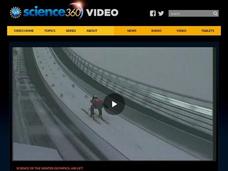MinutePhysics
Weigh a Million Dollars with Your Mind
Ever wonder if you could carry a million dollars? A video tutorial uses money to demonstrate estimation calculations. Using known values, the narrator builds an approximation for the weight of a million dollars.
MinutePhysics
Every Force in Nature (Theory of Everything, Part III)
Can you explain the standard model without doing the math? You bet! The short video uses sheep and currency exchange to express the fundamentals of the equation that explains everything. The narrator then relates the analogy to the...
MinutePhysics
Albert Einstein: Why Light is Quantum
While we are all familiar with what happens when you turn on a light bulb, Albert Einstein was convinced that there was more happening than meets the eye. The video describes his extension of the research of others to ultimately...
MinutePhysics
Einstein and The Special Theory of Relativity
Einstein's best-known work not only demonstrates that time itself is relative, but also shows how matter moves. An animated video illustrates the problem of motion, the concept of perspective, and the breakthrough idea that time is not a...
MinutePhysics
How Far is a Second?
How far is it from your house to the grocery store? If you answered in time rather than distance, there's a scientific explanation. Science scholars compare distance/time quantities in a short, animated video. Topics include time being...
MinutePhysics
Another Physics Misconception
Your physics class will really pick up speed after watching an insightful video about momentum! Learners discover the rest of the story of the P = mv equation. The narrator shows the difference between massed and massless objects in the...
MinutePhysics
Science, Religion, and the Big Bang
In the beginning, there was ... well, we don't know, exactly. Was there even a beginning to begin with? Amateur space scientists explore the nature of the origins of the universe in a brief video. Other topics include the misleading Big...
MinutePhysics
Relativity Isn't Relative
Discuss relativity as it relates to objects, science, and famous relativity theories. It offers ideas of why scientists don't use relative terms if they can avoid them. It even covers the concepts scientists once thought weren't relative...
MinuteEarth
How to Survive a Lightning Strike
What should you do if you are in the middle of a field when a lightning storm approaches? The video considers the best options for clothing, body position, and more. It highlights how cars and homes protect you from lightning and what...
Crash Course
Ampère's Law: Crash Course Physics #33
Give credit where credit is due—thank Ampere any time you use an electric motor! The 33rd installment in the Crash Course physics series explains how Ampere's Law applies to a long, straight wire. The discussion then expands to the...
Crash Course
Maxwell's Equations: Crash Course Physics #37
Electricity has an interesting history. Consider the development of electric current into usable forms while viewing the 37th lesson in a Crash Course video series on physics. Using Maxwell's Equations, the instructor addresses...
Crash Course
Light Is Waves: Crash Course Physics #39
Help your classes visualize light as a wave using an engaging video lesson. The 39th lesson of the Crash Course physics series highlights the characteristics of a light wave. The lesson continues by analyzing the behavior of waves during...
Crash Course
Nuclear Physics: Crash Course Physics #45
E=mc^2 is an important equation in the physics world. Help your classes understand its significance with a helpful video lesson. An episode of the Crash Course physics series offers an overview of nuclear physics and an explanation of...
Veritasium
The Original Double Slit Experiment
Is light a wave or a particle? The video recreates the double slit experiment with sunlight in public. Different individuals predict what they will see by looking into a dark box, which allows sunlight into it through two small slits....
Veritasium
How Do Chameleons Change Color?
Talk about weird science! Young biologists discover the amazing structures found in the skin of male chameleons during a video from Veritasium. The narrator discusses common myths about chameleon color change, what triggers the...
Be Smart
Is Space a Thing?
Travel through time to learn from some of the world's greatest scientists. The narrator of a thought-provoking video investigates the theories of Newton, Mach, and Einstein among others to determine if space itself is a thing. Viewers...
National Science Foundation
Science Friction—Science of the Winter Olympics
Physics plays a role in most sports, and curling is no exception! A video explains how a curling team controls the friction between the stone and the ice to modify its movement.
National Science Foundation
Blade Runners—Science of the Winter Olympics
Race to learn the insight of Sir Isaac Newton. A helpful video uses speed skating to explain Newton's laws of motion. Force, acceleration, mass, and momentum all work together to make a successful speed skating race.
National Science Foundation
Banking on Speed—Science of the Winter Olympics
Get on the right track! Young scholars learn about the importance of momentum and friction during a bobsled ride. A video lesson speaks to a bobsled designer to explain how he considers the physics during the design process.
National Science Foundation
Air Lift—Science of the Winter Olympics
Up, up, and away! Young scholars learn how to apply physics to a successful ski jump. An interesting video lesson compares and contrasts drag and lift in the context of a ski jump.
Physics Girl
Bizarre Spinning Toys
Objects don't always behave the way we think they will. A video lesson gives some clarity to the movement of spinning objects. The instructor applies the concepts of torque and angular momentum in an episode of a physics playlist.
Crash Course
Intro to History of Science: Crash Course History of Science #1
How, and where, did the scientific process as we know it begin? Journey back through time with the introductory video from Crash Course's History of Science series. The resource highlights what people do and don't know about the world,...
SciShow
The Hottest Planet Ever
Have you ever wanted to visit the sun? While that's not an option given the temperatures involved, use a SciShow Space video to learn about the probe headed to the sun to help people understand a few things that confuse scientists. The...
Numberphile
Tau Replaces Pi
If it ain't broke, don't fix it? Young mathematicians learn about the advantages of replacing pi with tau, such as a more conceptual understanding of radian measure. The video in the Numberphile Pi series also explains why such a move...

























